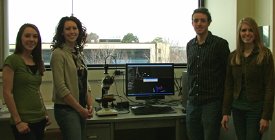The Department of Chemistry & Biochemistry at Brigham Young University (BYU) has chosen the NanoSight LM-10 system to support their research into the synthesis of inorganic nanoparticles, principally metal oxides.
 The NanoSight users at Brigham Young University
The NanoSight users at Brigham Young University
The BYU research team of Dr. Brian Woodfield are working on the development of an elegantly simple process that allows the group to make a nearly unlimited array of well-defined inorganic nanoparticles that have controlled sizes from 1 nm to bulk. The particles are highly crystalline with well defined shapes (usually spherical but also rods). The method produces them with chemical and phase purities as high as 99.9999% while the particle size distribution is controlled to approximately ±10%. Dr. Woodfield projects with confidence that they can make industrial size quantities with manufacturing costs significantly less than any other current technique.
Principal user is PhD candidate Betsy Olsen. She has been very impressed with the instrument. "The NanoSight is used to measure particle size as one way to quantify the amount of agglomeration in the process and to see if our de-agglomeration/dispersion techniques are working."
Olsen continued, "The system is used along side other techniques such as TEM and DLS. However, The NanoSight is much faster, less expensive and easier to run than TEM. It provides more control compared to DLS and other traditional particle size analyzers as it allows you to visualize what you are measuring particle by particle. For example, this means you can follow a polydispersed system more accurately."
NanoSight's approach, known as Nanoparticle Tracking Analysis (NTA), has been shown to be ideally suited to both research and process control use. The system is an extremely powerful nanoscale research and development tool for looking a broad range of particle types and concentrations.